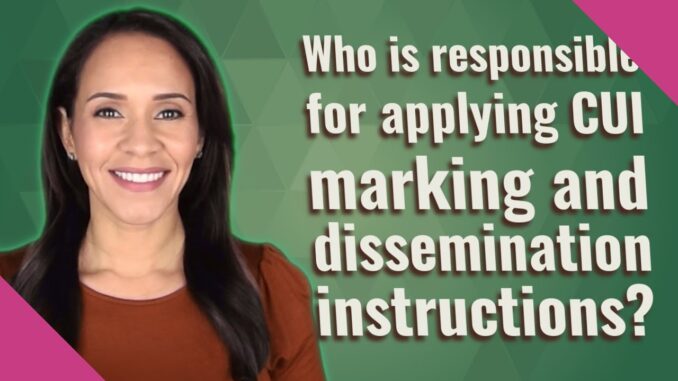
Data security has emerged as a top priority while expanding digital connectedness and continual sharing of sensitive information. The Controlled Unclassified Information (CUI) framework is an essential strategy to safeguard this information. Although neither “Top Secret” nor “Classified,” CUI contains information that must be handled carefully to avoid unauthorized access or exposure. Understanding Who is Responsible for Applying CUI Markings and Dissemination Instructions is crucial for protecting data integrity and confidentiality. This procedure is critical to information security.
CUI stands for Controlled Unclassified Information.
Controlled Unclassified Information refers to a broad spectrum of information that, although not classified, has to be protected because it is sensitive. This includes financial data, personally identifiable information (PII), confidential company information, and more. The CUI framework was created to standardize how such information is managed, exchanged, and distributed to limit risks and prevent illegal access.
CUI Markings Application
CUI markers are essential for highlighting the sensitivity of information and directing the proper management of it. The people who produce, administer, or handle the information are responsible for adding CUI marks. Depending on the setting and organizational structure, this role may vary, but it often includes the following significant figures:
Originators and Creators: The first application of the proper marks is the responsibility of those who develop CUI. Because of the proper labeling from the beginning, the information may be handled correctly throughout its existence.
Owners of the information: CUI owners—often those in administrative or supervisory positions—must examine and confirm the integrity of CUI marks. Before being shared, they make sure the content is categorized correctly.
Personnel Assigned: Some organizations assign specific individuals or groups the duty of monitoring CUI management and marking compliance. These people ensure that marking procedures are consistent and direct others inside the company.
Instructions for Distribution
Guidelines on sharing, transferring, or communicating information to others are known as dissemination instructions connected with CUI. These guidelines specify the proper ways to share sensitive information while ensuring security, making them as crucial as CUI marks. Dissemination teaching responsibility often falls within the following categories:
- Originators: Those who produce CUI must include concise distribution guidelines with the tagged data. These guidelines can list the approved recipients, describe the acceptable means for communication, and establish any restrictions on subsequent sharing.
- Owners of the information: Owners of CUI are responsible for confirming and approving the originators’ distribution guidelines. They ensure that the rules are consistent with the organization’s policies and the sensitivity of the data.
- Dissemination Managers: Teams or individuals may manage the CUI’s regulated sharing in more prominent companies. They check the guidelines, ensure everyone follows them, and help with secure communication techniques.
Conclusion
Various stakeholders must collaborate to apply CUI marks and distribution instructions, from those who create sensitive material to those in charge of its monitoring and appropriate transmission. A robust information security architecture is built based on precise marks and well-defined dissemination instructions. Organizations may successfully protect Controlled Unclassified Information and uphold data confidentiality and integrity in an increasingly interconnected world by knowing and performing their various responsibilities.
